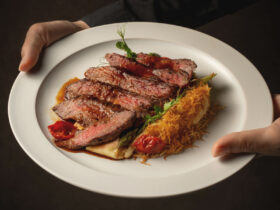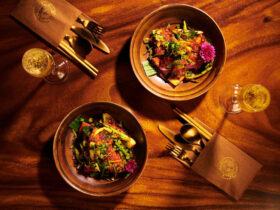Grain-fed or grass-fed? Sirloin or tenderloin? Wagyu or Kobe? Do you know what these statements mean or the differences between them? Take our Beef Connoisseur quiz to see how well you fare.
- What should you look out for in a piece of raw steak?
A. Colour, Smell & MarblingB. Colour, Texture & SizeC. Size, Cut & Colour
- Which part of the cow does the sirloin come from?
A. RumpB. Shin ShankC. Striploin
- How do you tell the difference between a real piece of steak and meat glue?
A. Points of fusion, colour variation and textureB. Fat to meat ratio, texture and tendernessC. Tenderness, cooking time and quality
- What is dry-aged beef?
A. Beef jerkyB. Meat that has been allowed to break down systematically resulting in a concentrated flavourC. Tough and old meat
- What’s the difference between grass-fed and grain-fed?
A. Grain-fed is more expensive than grassB. Grain-fed has more marbling while grass-fed is leanerC. Both are correct
- What is wagyu?
A. Same as Kobe beef
B. Breeds of Japanese steers that can come from other countries such as Australia and the USA
C A marketing tactic used by restaurants to upsell their beef - What is steak tartare made of?
A. Raw mincemeat and onion topped with a raw egg yolkB. Hand-minced raw tenderloin and onion topped with a raw egg yolkC. Corned beef topped with a raw egg yolk
- What is a sous-vide steak?
A. Meat cooked in a vacuum in water over a precise temperature for a longer amount of time with reduced shrinkage
B. Boiled steak
C. Another cut of meat from the cow
Answers
- Answer: A.
A fresh piece of steak carries a bright red appearance, steaks left on the shelf for a longer period turn brownish in colour because of oxidation. Fresh beef also has a meaty smell that does not give off an odour.Marbling is the network of fats within the lean meat of the steak; extensive marbling means the steak is more tender, juicy and flavourful. - Answer: C.
Striploin is also known as New York strip, porterhouse, and entrecote. More commonly, it is known as the sirloin.The alternative to the striploin is the shortloin which contains a bone usually used in T-bone steak dishes. - Answer: A.
It is quite often difficult to tell apart when cooked, but once a raw reconstituted steak is sliced through the middle; you will notice faint points of fusion where the chunks of meat have been pressed together.There will also be a slight colour difference due to the varied origins of the meat. The meat will be slightly powdery as well. - Answer: B.
Beef is aged to make it tender, develop its flavour, and reduce some of the variability in quality. Dry ageing is letting the raw meat “relax” by hanging it up in a controlled environment (temperature and humidity).“Relaxing” the meat allows the beef’s natural enzymes to break down the connective tissue in the muscle and this will give us beef that is tenderer than one that is cooked and consumed immediately after slaughter. Also, dry ageing allows moisture in the meat to evaporate, hence the higher concentration and stronger flavour of dry-aged meat. Beef is considered aged when stored at least ten days. - Answer: C.
All cattle begin by feeding on grass. Some finish off on grass while some finish off on grain or corn. A 200-plus day grain-fed Angus beef means during the last 200-plus days of the life of the Angus cattle, it was exclusively fed on grains in a feedlot.The high-energy grains allow the cattle to put on more marbling and fat. Grain-fed beef is fattier, juicier, tenderer and sweeter than those fed on grass.Grain-fed is also more expensive than grass-fed ones, because while the animals can feed on grass that grows in the farm, farmers have to purchase grains. - Answer: B.
Remember all Kobe beef is wagyu, but not all wagyu is Kobe beef.Kobe beef may come from the same breed of steers, but wagyu beef does not undergo processes that are as stringent to qualify as Kobe beef; including coming from the Hyogo prefecture. - Answer: B.
Contrary to popular belief, steak tartare is actually quite difficult to make. High quality meat has to be used and minced before adding dressings such as sauces or vinaigrettes. The sauce is then paired with suitable accoutrements.Top grade tenderloins are usually the best cuts for this. - Answer: A.
Sous-vide is ubiquitous in restaurants these days. Most steaks are cooked using the sous-vide method for a couple of hours. They are then given a quick post-sous-vide sear before serving.Unlike with traditional cooking, the steak does not need to rest to reabsorb juice – you can serve it immediately after searing.Facts from Wooloomooloo Group, Andre Huber of Huber’s Butchery, and some from web sources.
How You Measure
If you got 6-8 correct:
You, my friend, are a beef connoisseur. You know where your money is going and what exactly you are eating.
You are probably planning a visit to an excellent steakhouse of repute soon, and you will order your steak rare with no sauce; just a little sea salt and pepper.
If you got 3-5 correct:
You know some facts but not everything about steak and are easily wowed by the terminology on the menu.
Perhaps brush up a little so you don’t get ripped off by a glib-talking waiter who tells you what the management has told him to say.
If you got 0-2 correct:
Save yourself the pain and stick to fast food joints or mediocre steakhouses, where the steaks are more or less “well done” no matter what degree of doneness you specify.Or, better yet, order some chicken.
ADVERTISEMENTS





![#82_food_shutterstock_125734712-[Converted]](http://www.weekender.com.sg/e/wp-content/uploads/2014/05/82_food_shutterstock_125734712-Converted.jpg)





Leave a Reply